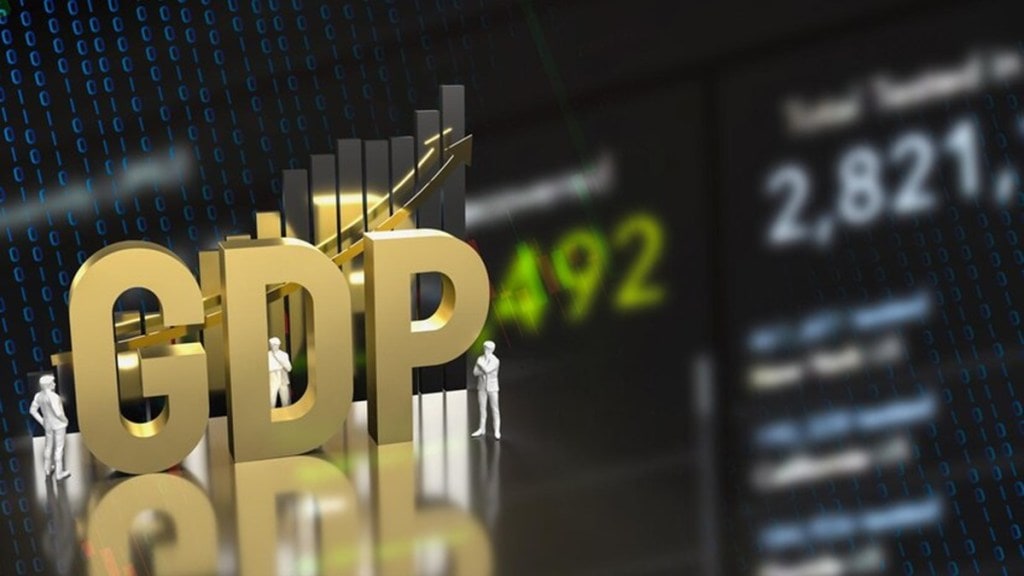By Prachi Mishra
In assessing India’s current economic landscape, it’s crucial to begin with some fundamental technical considerations regarding how we measure and interpret economic performance. The recent gross domestic product (GDP) growth figure of 5.4% in Q2FY25, compared to the previous quarter’s 6.7%, has garnered significant attention. However, this year-over-year comparison between quarters requires careful interpretation. When growth is decomposed, both momentum decline as well as base effects play a role, with the latter making a more substantial contribution.
Looking at absolute levels rather than growth rates of GDP also provides an important context, particularly in periods proximate to the pandemic. Current calculations indicate that the economy may be approximately 5% below its pre-pandemic trajectory, even while using a conservative 6% growth rate to project the pre-pandemic path and not taking into account the economic slowdown preceding the pandemic. This gap underscores the need for more ground to be covered in the recovery process.
That said, the momentum slowdown is noticeable, with the seasonally adjusted annual rate (SAAR) of GDP at market prices declining from 8% in the third quarter of calendar year 2023, to 3% in the third quarter of 2024. This trend aligns with the recent corporate earnings results and data on urban private consumption.
This deceleration appears largely cyclical and may represent a healthy correction in the economy. More specifically, it appears to be primarily policy-induced. Monetary policy underwent a significant 250 basis-point tightening in 2022, and given the considerable lags in monetary policy transmission these effects are likely still unfolding. Additionally, fiscal policy has seen approximately 200 basis points of tightening across FY24 and FY25. Regulatory measures, particularly those targeting consumer lending, have also contributed to the cooling effect.
This slowdown, therefore, may be viewed as a cyclical adjustment, largely driven by policy normalisation following stimulus measures implemented during the crisis, rather than indicating structural economic damage. The appropriate policy response to such a slowdown depends on accurately gauging its extent. Current estimates suggest that the level of output may be below potential, indicating a negative “output gap” that would warrant policy intervention. Given limited fiscal space, monetary policy presents itself as a viable tool for adjustment. With current real rates, whether measured ex-ante or ex-post, and compared with estimates of “neutral” or “equilibrium” rates (interest rate that keeps the economy in perfect balance — not too hot, not too cold, kind of like Goldilocks’ porridge) — there appears to be room for cautiously calibrating monetary policy. The impact of the recent reduction in cash reserve ratio (CRR), however, requires further analysis to determine its equivalent monetary policy effect.
Importantly, for any changes in monetary policy to transmit to the broader economy, the operating framework for liquidity management must align with monetary policy objectives. While the weighted average call rate traded close to target in 2024, it’s puzzling that financial conditions remain tight despite the significant CRR cut, likely driven by multiple factors including movements in the government’s cash balances at the central bank. As an easing cycle eventually starts, system liquidity would have to be in surplus, with the call rate trading below the repo rate, though not excessively so, to avoid implying a larger adjustment than policy rates suggest.
A persistent challenge lies in the transmission from policy rates to bank deposit rates. Despite the 250 basis-point tightening, transmission to deposit rates remains limited. This has resulted in elevated credit-deposit ratios, possibly also reflecting banks’ efforts to protect their net interest margins. The broader issue of transmission of policy changes to bank balance sheets’ liability side requires particular attention. Without smooth transmission to the liability side, the impact on the asset side and the broader macroeconomy will remain weak, uncertain, and subject to extended lags.
Looking ahead, recent economic indicators present a mixed picture. On the positive side, festival demand has been robust, with some encouraging services purchasing managers’ index (PMI) signals. On the other hand, some concerning indicators have emerged. The manufacturing PMI declined to a one-year low of 56.4 in December, primarily due to a decrease in the output index. The first eight months of FY25 showed a contraction in public capital expenditure, and listed companies reported weak sales. A firm-level survey by Abhiman Das at Indian
Institute of Management Ahmedabad also indicates that 60% of respondents reported “somewhat less than normal” sales, and credit growth, especially to small and medium industries, remains weak.
Continued monitoring and research are essential to better understand the structural versus cyclical nature of the current slowdown, and its potential long-term economic implications. This understanding will be crucial in calibrating appropriate policy responses moving forward.
The writer is Professor of economics, Ashoka University, & director and head, Ashoka Isaac Center for Public Policy.
Disclaimer: Views expressed are personal and do not reflect the official position or policy of FinancialExpress.com. Reproducing this content without permission is prohibited.

